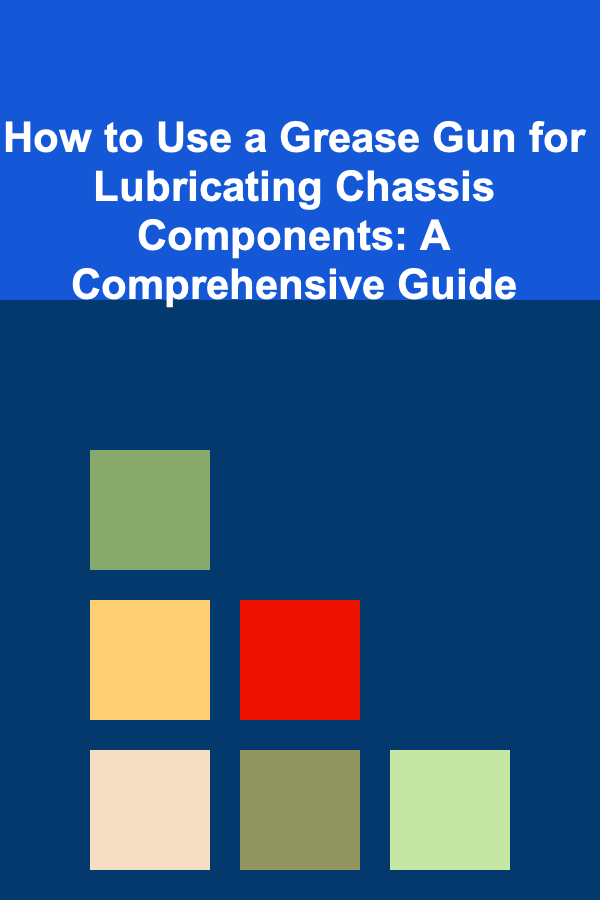
How to Use a Grease Gun for Lubricating Chassis Components: A Comprehensive Guide
ebook include PDF & Audio bundle (Micro Guide)
$12.99$10.99
Limited Time Offer! Order within the next:

Proper lubrication is paramount for the longevity and efficient operation of any vehicle or machine with moving parts. Neglecting lubrication leads to increased friction, accelerated wear and tear, overheating, and ultimately, component failure. The chassis, comprised of critical suspension and steering components, is particularly susceptible to these issues. The grease gun is the primary tool for delivering grease to these hard-to-reach lubrication points (often called "zerks" or "grease fittings"), ensuring smooth operation and extending the lifespan of these vital parts. This comprehensive guide will cover everything you need to know about using a grease gun effectively and safely for chassis lubrication.
Understanding the Importance of Chassis Lubrication
The chassis, the backbone of a vehicle or machine, supports the weight and withstands the forces generated during operation. Key components within the chassis, such as ball joints, tie rod ends, universal joints (U-joints), and steering linkages, are designed to move and articulate, allowing for steering and suspension movement. These components rely on a thin film of lubricant to reduce friction between moving surfaces, preventing metal-to-metal contact. Without proper lubrication:
- Friction Increases: Dry or inadequately lubricated components experience increased friction, leading to higher operating temperatures and reduced efficiency. This translates to increased fuel consumption and reduced performance.
- Wear and Tear Accelerates: Metal-to-metal contact causes accelerated wear and tear on the moving parts. This can lead to loose connections, excessive play, and eventual component failure.
- Corrosion Occurs: Grease not only lubricates but also acts as a barrier against moisture and contaminants that can cause corrosion. Regular lubrication helps prevent rust and corrosion, extending the life of the components.
- Noise Increases: A lack of lubrication often manifests as squeaking, creaking, or grinding noises emanating from the chassis components. These noises are early indicators of a lubrication problem.
- Component Failure: Untreated lubrication issues will ultimately lead to component failure, requiring costly repairs and downtime. For example, a failed ball joint can cause loss of steering control, posing a serious safety hazard.
Regular chassis lubrication is a preventative maintenance measure that minimizes these risks, ensuring safe and reliable operation.
Types of Grease Guns
Grease guns come in various types, each with its own advantages and disadvantages. Understanding the different types will help you choose the right one for your needs:
Manual Grease Guns
Manual grease guns are the most common and affordable type. They rely on manual force to dispense grease. There are two main types of manual grease guns:
- Lever-Type Grease Guns: These guns use a lever that you repeatedly pump to generate pressure and dispense grease. They are simple to operate and relatively inexpensive. However, they require two hands to operate, one to hold the gun and the other to pump the lever. This can be challenging when working in tight spaces. The amount of grease dispensed per pump is relatively consistent.
- Pistol-Grip Grease Guns: These guns have a pistol-grip handle that you squeeze to dispense grease. They can be operated with one hand, making them more convenient for certain applications. The amount of grease dispensed can be variable depending on how hard you squeeze the trigger. They generally deliver less pressure than lever-type guns.
Pneumatic (Air-Powered) Grease Guns
Pneumatic grease guns use compressed air to generate pressure and dispense grease. They offer several advantages over manual guns:
- Effortless Operation: They require minimal effort to operate, reducing fatigue during prolonged use.
- Consistent Grease Delivery: They provide a consistent and adjustable grease flow.
- Faster Lubrication: They can deliver grease more quickly than manual guns.
However, pneumatic grease guns require an air compressor and air hose, making them less portable and suitable primarily for workshop environments. They also tend to be more expensive than manual grease guns.
Electric Grease Guns
Electric grease guns are battery-powered and offer a combination of convenience and power. They are similar to pneumatic guns in that they require minimal effort and provide consistent grease delivery. They offer the following benefits:
- Portability: They are cordless and can be used anywhere, making them ideal for field service or remote locations.
- Consistent Grease Delivery: They deliver a consistent and adjustable grease flow.
- Ease of Use: They are very easy to operate with a simple trigger mechanism.
Electric grease guns are generally more expensive than manual guns and require charging or battery replacement. Battery life can also be a limiting factor depending on the amount of lubrication required.
Choosing the Right Grease
Selecting the correct type of grease is crucial for proper lubrication. Using the wrong grease can lead to incompatibility issues, reduced lubrication performance, and even damage to the components. Factors to consider when choosing grease include:
- NLGI Grade: The National Lubricating Grease Institute (NLGI) grade indicates the consistency of the grease. Common NLGI grades for chassis lubrication are 1, 2, and 3. NLGI 2 is a general-purpose grease suitable for most chassis applications. Higher NLGI grades are thicker and may be used for heavily loaded or slow-moving components. Lower NLGI grades are thinner and suitable for low-load, high-speed applications.
- Base Oil Viscosity: The base oil viscosity is a measure of the oil's resistance to flow. Higher viscosity oils are better suited for high-load, low-speed applications, while lower viscosity oils are better for low-load, high-speed applications.
- Thickener Type: The thickener is the component that gives the grease its consistency. Common thickener types include lithium, lithium complex, calcium sulfonate, and polyurea. Lithium-based greases are widely used and offer good general-purpose performance. Lithium complex greases offer improved high-temperature performance and water resistance. Calcium sulfonate greases provide excellent corrosion protection and water resistance. Polyurea greases are suitable for high-temperature applications and offer long service life.
- Additives: Greases often contain additives to enhance their performance. Common additives include extreme pressure (EP) additives, anti-wear additives, corrosion inhibitors, and oxidation inhibitors. EP additives provide enhanced protection under high-load conditions. Anti-wear additives reduce friction and wear. Corrosion inhibitors protect against rust and corrosion. Oxidation inhibitors prevent the grease from breaking down at high temperatures.
- Manufacturer Recommendations: Always consult the vehicle or machine's owner's manual or the component manufacturer's recommendations for the specific grease type required. Using the recommended grease will ensure optimal performance and prevent damage.
Using the correct grease is just as important as using a grease gun correctly. Incorrect grease can lead to premature wear and component failure.
Essential Equipment and Supplies
Before you begin lubricating the chassis, gather the necessary equipment and supplies:
- Grease Gun: Choose the appropriate type of grease gun based on your needs and the environment you'll be working in.
- Grease Cartridge: Select the correct type of grease, as discussed above. Make sure the grease cartridge is compatible with your grease gun.
- Grease Gun Coupler (Grease Gun Nozzle): Standard, needle-nose, or right-angle couplers are available for different grease fitting access situations. Choose the coupler that best suits the grease fittings you'll be lubricating.
- Clean Rags: Use clean rags to wipe off excess grease and clean grease fittings.
- Gloves: Wear gloves to protect your hands from grease and dirt.
- Safety Glasses: Wear safety glasses to protect your eyes from grease splatter.
- Jack and Jack Stands (Optional): If necessary, use a jack and jack stands to safely raise the vehicle for better access to the grease fittings. Never work under a vehicle supported only by a jack.
- Wheel Chocks (Optional): Use wheel chocks to prevent the vehicle from rolling.
- Wire Brush or Pick (Optional): Use a wire brush or pick to clean dirt and debris from around the grease fittings.
- Penetrating Oil (Optional): Use penetrating oil to loosen stubborn grease fittings.
- Grease Fitting Removal Tool (Optional): Use a grease fitting removal tool to replace damaged or missing grease fittings.
Having all the necessary equipment and supplies readily available will make the lubrication process more efficient and safer.
Step-by-Step Guide to Using a Grease Gun
Follow these steps to properly lubricate the chassis components:
1. Preparing the Grease Gun
- Load the Grease Cartridge:
- Unscrew the grease gun head from the body.
- Pull back the plunger rod as far as it will go.
- Insert the grease cartridge into the grease gun body.
- Remove the cap from the grease cartridge.
- Screw the grease gun head back onto the body, ensuring a tight seal.
- Push the plunger rod into the grease cartridge to engage it. Some grease guns have a vent to release trapped air. Use it if applicable.
- Prime the Grease Gun:
- Point the grease gun nozzle towards a rag or container.
- Operate the grease gun (pump the lever or squeeze the trigger) until grease starts to flow from the nozzle. This removes any air pockets in the grease gun and ensures that you are dispensing grease, not just air. Continue until the grease flows consistently.
- Attach the Correct Coupler: Select the appropriate grease gun coupler for the grease fittings you'll be lubricating. Screw the coupler onto the grease gun nozzle. Make sure it's tightened securely.
2. Locating Grease Fittings
Grease fittings, also known as zerks, are small metal fittings that allow grease to be injected into the component. They are typically located on ball joints, tie rod ends, U-joints, and steering linkages. Consult your vehicle or machine's service manual or lubrication chart for the exact location of all grease fittings. Common locations include:
- Ball Joints: Upper and lower ball joints on the front suspension.
- Tie Rod Ends: Inner and outer tie rod ends, connecting the steering rack or box to the steering knuckles.
- U-Joints: Universal joints on the driveshaft. Some U-joints are sealed and do not require lubrication.
- Steering Linkages: Pitman arm, idler arm, and other steering linkages.
- Leaf Spring Shackle Bolts: On vehicles with leaf spring suspensions.
If you are unsure of the location of the grease fittings, consult the vehicle's repair manual. Some components may not have grease fittings if they are sealed or "lubed for life."
3. Cleaning the Grease Fittings
Before attaching the grease gun, clean the grease fitting thoroughly using a clean rag or wire brush. This will remove any dirt, debris, or old grease that could contaminate the new grease and damage the component. Pay particular attention to the area around the fitting to ensure a good seal when connecting the grease gun.
If the grease fitting is clogged or stuck, try the following:
- Use Penetrating Oil: Spray penetrating oil onto the fitting and let it soak for several minutes to loosen any debris.
- Tap the Fitting: Gently tap the fitting with a hammer to dislodge any debris.
- Use a Grease Fitting Cleaning Tool: These tools use pressure to force grease through a clogged fitting.
If the grease fitting is damaged or cannot be cleaned, it may need to be replaced.
4. Applying the Grease
- Attach the Grease Gun Coupler: Securely attach the grease gun coupler to the grease fitting. Ensure a tight seal to prevent grease from escaping. You should feel the coupler "click" into place.
- Dispense Grease Slowly: Pump the grease gun handle or squeeze the trigger slowly and steadily. Watch for the old grease to be pushed out of the joint. Do not over-grease.
- Observe the Joint: As you pump the grease, observe the joint for any signs of over-greasing. You should see the old grease being pushed out from the seals or joints. Stop pumping when fresh grease appears or when the joint is full.
- Listen for Changes: Pay attention to the sound of the grease gun and the feel of the joint. If you hear a change in sound or feel resistance, it may indicate that the joint is full or that there is a blockage.
- Wipe Away Excess Grease: Once you have finished lubricating the joint, remove the grease gun coupler and wipe away any excess grease with a clean rag. This will prevent dirt and debris from accumulating around the fitting.
The goal is to inject enough grease to displace the old, contaminated grease and replenish the lubricant film. Over-greasing can damage seals and attract dirt, so it's important to avoid excessive grease application.
5. Repeat for All Grease Fittings
Repeat the process for all grease fittings on the chassis components, following the lubrication schedule recommended by the manufacturer. Pay attention to the specific requirements of each joint and adjust the amount of grease accordingly.
Important Considerations and Best Practices
To ensure safe and effective chassis lubrication, keep the following points in mind:
- Safety First: Always prioritize safety. Wear gloves and safety glasses to protect yourself from grease and debris. If raising the vehicle, use jack stands and wheel chocks to prevent accidents.
- Regular Lubrication Schedule: Follow the manufacturer's recommended lubrication schedule. Regular lubrication is essential for preventing premature wear and tear. Factors such as driving conditions, vehicle usage, and environmental factors can affect the frequency of lubrication. Vehicles operating in dusty or wet environments may require more frequent lubrication.
- Inspect Components Regularly: During the lubrication process, inspect the chassis components for any signs of damage, wear, or corrosion. Pay attention to ball joints, tie rod ends, U-joints, and steering linkages. Replace any worn or damaged components immediately.
- Avoid Over-Greasing: Over-greasing can damage seals and attract dirt, leading to premature wear. Pump grease slowly and observe the joint carefully. Stop pumping when fresh grease appears or when the joint is full.
- Use the Correct Grease: Using the wrong grease can lead to incompatibility issues, reduced lubrication performance, and even damage to the components. Always consult the vehicle or machine's owner's manual or the component manufacturer's recommendations for the specific grease type required.
- Cleanliness is Key: Keep the grease gun, grease fittings, and work area clean to prevent contamination. Wipe off excess grease and clean grease fittings before and after lubrication.
- Proper Storage: Store the grease gun and grease cartridges in a clean and dry place to prevent contamination and corrosion. Keep the grease gun nozzle capped to prevent dirt and debris from entering the gun.
- Dispose of Used Grease Properly: Dispose of used grease and grease cartridges in accordance with local regulations. Do not dispose of grease down drains or into the environment.
By following these guidelines, you can ensure that your chassis components are properly lubricated, extending their lifespan and ensuring safe and reliable operation.
Troubleshooting Common Problems
Even with proper technique, you may encounter some common problems when using a grease gun:
- Grease Gun Won't Pump:
- Check the grease cartridge: Make sure the cartridge is not empty.
- Check for air pockets: Purge any air pockets from the grease gun by opening the vent valve (if applicable) and operating the gun until grease flows consistently.
- Check for clogged nozzle or coupler: Clean the nozzle and coupler with a wire or pick.
- Check the plunger rod: Make sure the plunger rod is properly engaged with the grease cartridge.
- Grease Leaks from the Coupler:
- Ensure a tight seal: Make sure the coupler is securely attached to the grease fitting.
- Check the coupler for wear: Replace the coupler if it is worn or damaged.
- Use the correct coupler: Ensure you are using the correct type of coupler for the grease fitting.
- Grease Fitting is Clogged:
- Use penetrating oil: Spray penetrating oil onto the fitting and let it soak for several minutes.
- Tap the fitting: Gently tap the fitting with a hammer to dislodge any debris.
- Use a grease fitting cleaning tool: These tools use pressure to force grease through a clogged fitting.
- Replace the fitting: If all else fails, replace the grease fitting.
- Difficult to Attach Coupler:
- Clean the grease fitting: Remove dirt and debris that may be preventing a secure connection.
- Use a different coupler: Some couplers are easier to attach than others. Try a different type.
- Ensure proper alignment: Make sure the coupler is aligned properly with the grease fitting.
Conclusion
Using a grease gun effectively is a fundamental skill for anyone maintaining vehicles or machines with chassis components. By understanding the importance of lubrication, choosing the right grease and equipment, following the proper techniques, and troubleshooting common problems, you can ensure that your chassis components are properly lubricated, extending their lifespan and ensuring safe and reliable operation. Remember to prioritize safety and follow the manufacturer's recommendations for lubrication schedules and grease types. Regular lubrication is a small investment that can save you significant time and money in the long run by preventing costly repairs and downtime.

Exploring Passive Income Ideas with Deep Learning Technology
Read More
How to Build a Checklist for Planning a Team-Building Event
Read More
How to Decorate Your Bedroom on a Budget for Maximum Comfort
Read More
How to Make a Checklist for Posting Consistently on Social Media
Read More
How To Master Grid Systems for Organized Layouts
Read More
How to Use Tiered Organizers for Better Visibility
Read MoreOther Products

Exploring Passive Income Ideas with Deep Learning Technology
Read More
How to Build a Checklist for Planning a Team-Building Event
Read More
How to Decorate Your Bedroom on a Budget for Maximum Comfort
Read More
How to Make a Checklist for Posting Consistently on Social Media
Read More
How To Master Grid Systems for Organized Layouts
Read More